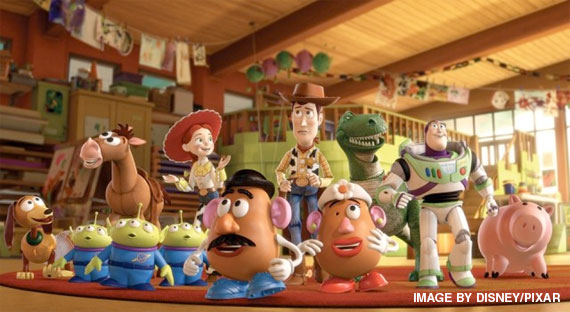A friend mentioned as we walked out of the theater for “Toy Story 3,” “If you look at all three movies, [they paint] a perfect history of computer animation.” Yet, more so than just visuals, Pixar’s latest in the toy-tastic trilogy is a lesson in the history of the company’s films. The movie is a love letter to those of us who grew up with the “Toy Story” franchise, starting with the original in 1995, and the company’s public efforts since then.
The latest “Toy Story” may not look groundbreaking from stills, retaining the visual style of the other movies to a tee, but throughout the film’s 105 minute runtime, Pixar throws tricks into the computer-generated magic you see on-screen. Beginning with an opening fantasy sequence that incorporates a nuclear cloud of Monkeys in a Barrel, the animation wizards behind the scenes show off just how far the tools of the trade have come. While many of the characters maintain their simplicity, the advancement of the environments they live in and the amount of detail packed into some key scenes is a treat. The cinematic treatment is equally well done, with angles and shots that make you smile from their integration and inventiveness.
Leave it to Pixar to overcome visual pizazz with a moving, engrossing story in the third movie of a trilogy. Far from a half-hearted attempt to cash in from the franchise’s success, the development of the story and the sheer quality of the writing rivals some of their best works. As previously mentioned, “Toy Story 3” is, at its core, the original film aged 15 years to perfectly adapt to its original audience. Pixar usually makes films that kids and grown-ups equally adore, but this one, even more so than “Wall-E” or “Up,” is directed at the 18–24 year old group.
The plot of the film, which portrays what happens to Woody, Buzz and the gang after their owner, Andy, packs for his impending college move, may start out lighthearted, but takes a welcome dark turn at the halfway point. The daycare to which the toys are mistakenly donated, ironically named Sunnyside Daycare, is far from sunshine and rainbows. To avoid spoilers, let’s just say that not everything is as it seems, and what follows involves surprising twists and struggles with what growing up and moving on from childhood is all about. The ensuing escape plan hatched by Woody pulls from the best prison escape films while managing to stay hilarious and heartfelt like the best animated movies.
The number of vintage toys and Easter eggs Pixar crammed into the flick is also sure to provide gleeful nostalgia and excitement at the fact that none are wasted. They didn’t just throw in a cymbal-crashing monkey or hilarious Ken doll for kicks. Like the toddlers in the daycare, I feel that little kids watching the movie may be in for the visceral fun, watching animated toys spring into action, but they won’t understand the more realized deeper joy. A double whammy of sadness and joy in the final act will leave you surprised, elated and, then, bawling your eyes out — all in the span of 15 minutes.
The geniuses behind the scenes not only find the perfect way to wrap up the movie, but also close the curtain on an era of Pixar that seems to be passing the directorial and commercial torches. A couple of years ago, when Pixar announced their production schedule for 2009–2012, many groaned at the appearance of three sequels: this movie, “Cars 2” and “Monsters Inc. 2.”
Far tighter in terms of how all the pieces of the cinematic puzzle fit together than previous “Toy Stories,” “Toy Story 3” is one of Pixar’s best films — maybe even better than the first, if less historic. If you have yet to see this movie, please do so — though judging by its box office dominance, you probably have. Whether you’re seeing the film for the first, second or even third time, “Toy Story 3” proves playtime isn’t just for kids.

























